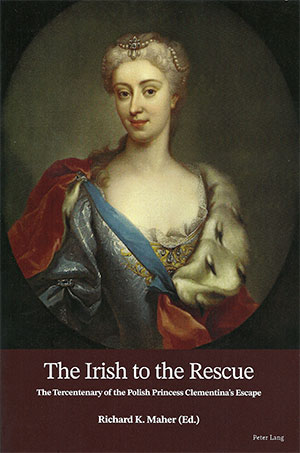THE IRISH TO THE RESCUE: THE TERCENTENARY OF THE POLISH PRINCESS CLEMENTINA’S ESCAPE
Published in Book Reviews, Book Reviews, Issue 5 (September/October 2021), Reviews, Volume 29 RICHARD K. MAHER (ed.)
RICHARD K. MAHER (ed.)
Peter Lang
£30
ISBN 9781789979343
Reviewed by Tony Canavan
Tony Canavan is Consultant Editor of Books Ireland.
While the title of this book may be eye-catching, it does not do justice to the breadth and depth of the essays it contains. Based on a seminar held in 2019 to commemorate the tercentenary of the rescue of the Princess Clementina Sobieska by a group of Irish exiles led by Charles Wogan, the book uses that event as the starting-point for discussions on the Jacobite cause, the Sobieski dynasty, great power politics and more.
The opening essay by Éamonn Ó Ciardha gives the reader an overview of the Irish in Europe, popularly known as the Wild Geese. He demonstrates that they were a complex, extensive community. While the soldiers may be the best known, Irishmen and Irishwomen occupied positions across society ranging from merchants and governors to clerics and educators. While he critiques the myth of the ‘fighting Irish’, he emphasises the importance of adherence to the Jacobite cause as a key factor in recruitment. These soldiers were not mere mercenaries but believed that service in an Irish regiment in France or Spain meant the chance to strike a blow at the Hanoverians and restore the Stuarts to the throne. It is in this context that we must consider Charles Wogan’s devotion to the Stuart cause.
The other element in Wogan’s story is the kingdom of Poland, and Jarosⱡav Pietrzak provides a good history of the Sobieski dynasty and Polish politics for those unacquainted with this subject. The Sobieskis came to prominence in the sixteenth century, their rise culminating in the election of Jan III as king. Poland was a major power in central Europe and the Sobieski dynasty had close ties with the French Bourbons. Hence the granddaughter of Jan III, Princess Maria Clementina, had family ties with the French monarchy and other royal families. That is why she was deemed a good match for James Stuart, and why the British government sought to halt such a marriage.
The editor, Richard K. Maher, provides a lively account of the actual rescue of Clementina from Hapsburg custody in Innsbruck. It was a chivalrous, gallant adventure, which caught the imagination of Europe at the time and reads like an adventure story (there was even a film in 1954, The Iron Glove, starring Robert Stack). In the following essay, Maher analyses Wogan’s adherence to the Stuart cause. Like so many, Wogan ultimately became disillusioned with the Stuarts. He fell victim to the intrigues of the Jacobite court and never received the reward his deeds deserved, and on the wider stage he regretted the sacrifice of thousands of Irish soldiers serving foreign kings in the hopes of helping Ireland. This is the other side of the coin to the popular, romantic image of the Irish brigades on the battlefields of Europe.
Those battlefields were part of the wars fought by the great powers, which might simply be expressed as France and its allies against the Holy Roman Empire and its allies. In his essay, Declan M. Downey guides the reader skilfully through the shifting sands of alliances and wars of succession. He illustrates how the fortunes of the Jacobite cause were affected by changes in the balance of power and the interests of particular monarchies. The Stuarts, and the Irish regiments, became pawns in the game and were brought onto the board or dropped as priorities changed. Despite the popular view in Ireland and Britain of the Hanoverians as a strictly Protestant dynasty, in reality there was religious tolerance in Hanover and the Hanoverian royals had marriage ties with the Hapsburgs. That is one of the reasons why the Catholic Charles V cooperated with the Protestant George I to keep him on the British throne. Interestingly, Downey also highlights that the Irish in the Holy Roman Empire were not Jacobites, having already given up on the Stuarts.
Away from dynastic politics, Edward Corp narrows in on the affairs of the Jacobite court and Princess Clementina’s place there after her marriage to Prince James. He paints a depressing picture of petty intrigue and ambition, as one faction plotted against another. We have seen how Wogan was the victim of such intrigue, and Corp tells us that Clementina was another. Ironically, given that James II was overthrown because he was a Catholic, the Jacobite court came to be dominated by a clique of Scottish Presbyterians who were hostile to the Catholic Polish princess. Her husband does not come across well and it would seem that, once she provided him with two male heirs, he had no interest in maintaining cordial relations. Consequently, their marriage was unhappy and short-lived.
The narrow focus continues with the final two essays, as Aneta Markuszewska dissects the political allusions in music dedicated to James and Clementina, and Estelle Gittins examines their marriage certificate and other Jacobite relics in Trinity College, Dublin. Both essays reveal the importance of looking beyond the obvious and the information that can be gleaned from apparently obscure sources.
Whether one is interested in the Jacobite cause or not, this is an interesting and enlightening book. The text is enlivened with illustrations while the subject-matter ranges beyond Clementina’s rescue, as it takes in the history of Poland, politics in central Europe and the great power struggles. In all of this, the Stuarts and their followers were more often pawns rather than players.
















